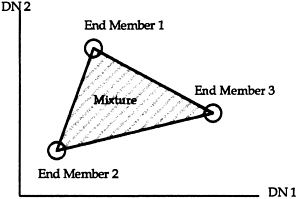93.
| [Cover] [Contents] [Index] |
Page 181

Figure 4.18 Three end members form a triangle in a two-dimension space. Mixed pixels should be located within the triangle.
To introduce the linear mixture model, consider an example in which there are three features (e.g. spectral bands) and two end members. All image pixels are assumed to be formed by simple mixing of these end members, as described by the following equations:
 |
(4.43) |
where xi is an observed pixel value in band i, and ai and bi are the known spectral reflectance values of the two end members on band i, and fj is the proportion of end member j to be estimated. Thus, the observed value of xi is assumed to be formed by mixing the end members in the proportion f1:f2. In general, the following constraints are added:
 |
(4.44) |
Equations (4.43) and (4.44) form a linear system of equations, the solution of which is subject to the constraint that the number of estimated parameters is less than the number of equations, i.e. c=k+1, where c is the number of end members, and k is the number of spectral bands. The solution for the proportions fj can be estimated using least-squares methods. With respect to the example given in Equation (4.43), the squared error e2 based on the above equations can be expressed as:
 |
(4.45) |
The least-squares solution is obtained by setting
| [Cover] [Contents] [Index] |
EAN: 2147483647
Pages: 354